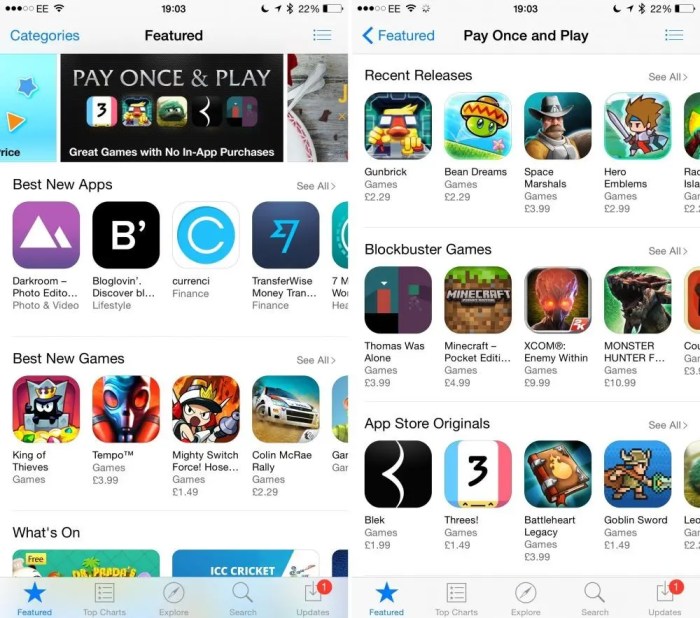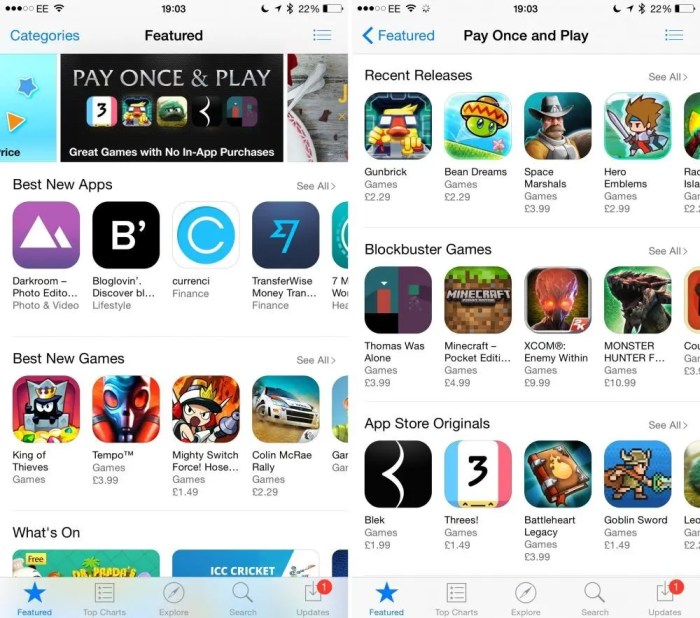The enduring appeal of classic games meets the modern demand for distraction-free entertainment in the realm of “no ad classic games iPhone.” This exploration delves into the preferences of users seeking this specific type of mobile gaming experience, examining the key features they value and the frustrations advertisements can cause. We’ll navigate the market landscape, analyzing pricing strategies, successful marketing campaigns, and the design considerations crucial for creating engaging ad-free games.
From understanding the technical requirements of iOS development and choosing suitable game engines, to crafting a seamless user experience and implementing secure in-app purchases, this guide offers a holistic perspective on bringing a successful ad-free classic game to the iPhone App Store. We’ll also explore monetization strategies that don’t rely on intrusive advertising, ensuring a positive and rewarding experience for both developers and players.
Understanding User Preferences
The target audience for ad-free classic games on iPhone comprises users seeking a nostalgic and uninterrupted gaming experience. These individuals value simplicity, straightforward gameplay, and a distraction-free environment, prioritizing gameplay over monetization strategies. They are often willing to pay a one-time fee for a premium, ad-free experience, reflecting a preference for quality over free-to-play models prevalent in many mobile games.
This user base appreciates the charm of classic game mechanics and designs, often seeking titles that evoke memories of simpler gaming eras. They are less interested in complex in-app purchases, intricate social features, or the constant interruptions associated with advertising. The primary motivation for this user group is pure, unadulterated enjoyment of the game itself.
Key Features and Functionalities
Users in this demographic prioritize core gameplay mechanics and intuitive controls above all else. Features such as smooth controls, responsive gameplay, challenging yet rewarding levels, and a polished user interface are highly valued. A clear and concise game design, free from unnecessary complexity, is crucial. Additional features such as customizable controls, multiple difficulty settings, and leaderboards can enhance the overall experience, but are secondary to the core gameplay loop. The absence of intrusive advertisements is a defining factor in their selection process.
Frustration Caused by Advertisements in Classic Games
Advertisements significantly disrupt the immersive experience offered by classic games. The interruption of gameplay, particularly in short, focused sessions common with classic game styles, is a major source of frustration. Full-screen video ads, especially, break the flow and immersion, often leading to negative player sentiment and potentially causing players to abandon the game entirely. Even less intrusive banner or interstitial ads can detract from the aesthetic appeal and overall enjoyment of a classic game’s simple design. The jarring contrast between the simplistic charm of a classic game and the often flashy and modern design of mobile advertisements creates a significant disconnect for users seeking a nostalgic gaming experience.
Types of Classic Games
The “no ad classic games iPhone” category encompasses a diverse range of genres. Puzzle games, such as Tetris or Minesweeper, benefit significantly from an ad-free environment due to their short, focused gameplay sessions. Arcade games, like Pac-Man or Space Invaders, also thrive in a distraction-free setting, allowing players to fully concentrate on the challenge. Role-Playing Games (RPGs) of a simpler, classic design, with turn-based combat and straightforward narratives, also find a receptive audience among users seeking a premium, uninterrupted experience. The common thread is a focus on simple, engaging gameplay that is best experienced without the interruptions caused by advertisements.
Market Analysis of Ad-Free Classic Games
The iPhone App Store boasts a diverse range of classic games, many of which have successfully transitioned to ad-free models, demonstrating a viable market for premium gaming experiences. This analysis explores the pricing strategies, marketing tactics, and potential strategies for a new ad-free classic game.
Pricing Strategies of Ad-Free Classic Games
Popular ad-free classic games on the App Store employ a range of pricing strategies, often reflecting the game’s complexity, features, and perceived value. Many opt for a one-time purchase model, with prices varying from a few dollars for simpler titles to upwards of $10 for more complex or feature-rich games. Some developers also utilize a freemium model, offering a basic version for free with in-app purchases for additional content or features. This approach, while less common for strictly “classic” games, can be successful for titles offering extensive replayability or expansions. The success of each pricing strategy is highly dependent on the game’s specific features and target audience. For example, a simple puzzle game might succeed with a lower price point, while a more complex RPG could justify a higher price.
Successful Marketing Campaigns for Ad-Free Classic Games
Several successful ad-free classic games have leveraged targeted marketing campaigns to reach their audience. Retro-themed games often benefit from marketing on social media platforms frequented by nostalgic gamers, such as Reddit’s r/gaming or Facebook groups dedicated to specific retro game consoles. Content marketing, such as showcasing gameplay videos on YouTube or writing blog posts about the game’s development, can also build anticipation and generate organic interest. Furthermore, influencer marketing, partnering with gaming YouTubers or Twitch streamers, can provide significant exposure. For instance, a successful campaign might involve a prominent retro gaming YouTuber reviewing the game and offering a giveaway to their subscribers. This type of campaign can generate significant buzz and drive downloads.
Hypothetical Marketing Plan for a New Ad-Free Classic Game
This hypothetical marketing plan targets a demographic of 25-45 year-olds with a nostalgic interest in classic arcade games and puzzle games. This age group often possesses disposable income and a fondness for retro gaming. Marketing channels would include:
- Social Media Marketing: Targeted ads on platforms like Facebook, Instagram, and Twitter, focusing on users interested in retro gaming, puzzle games, and classic arcade titles.
- App Store Optimization (ASO): Optimizing the app’s title, description, and s to improve its visibility in App Store search results.
- Influencer Marketing: Partnering with relevant gaming YouTubers and Twitch streamers to review and promote the game.
- Public Relations: Reaching out to gaming news websites and blogs to secure reviews and coverage.
- Content Marketing: Creating blog posts, articles, and videos showcasing the game’s features and gameplay.
The game would be priced at $4.99, reflecting its complexity and features. This price point balances accessibility with perceived value.
App Store Page UI Design
The following table illustrates a responsive design for the app store page, using a four-column layout for larger screens and collapsing to a single column on smaller screens.
| Screenshot 1 | Game Features | Screenshot 2 | Reviews |
|---|---|---|---|
|
Image of the game’s main menu, showcasing vibrant retro graphics and intuitive interface. |
|
Image showcasing gameplay, highlighting the challenge and fun elements. |
|
|
More screenshots could be added here, showcasing different aspects of the game, like special levels or power-ups. |
|||
Game Design Considerations

Successfully reviving classic games for a modern audience requires a delicate balance between preserving nostalgic charm and incorporating contemporary design elements to enhance engagement and monetization. This involves understanding the core appeal of classic games while addressing the expectations and preferences of today’s players accustomed to more sophisticated gameplay and intuitive interfaces.
The enduring appeal of classic games often stems from their simple yet engaging mechanics, compelling narratives (even if implicit), and the sense of challenge they provide. Modern players, however, expect a higher level of polish, intuitive controls, and perhaps a more visually stimulating experience. The challenge lies in updating these aspects without sacrificing the core elements that made the original game a classic.
Modernizing Classic Game Mechanics
Modernizing classic games for mobile platforms requires careful consideration of gameplay mechanics. While preserving the core loop is crucial, adding features that enhance engagement without disrupting the original experience is key. For example, incorporating leaderboards, achievements, and daily challenges can provide additional incentives for players to return to the game without relying on intrusive advertisements. Consider the classic game “Tetris.” While its core gameplay remains unchanged, the addition of leaderboards and themed skins (a monetization opportunity) has greatly enhanced its longevity and appeal across generations. Similarly, incorporating subtle visual improvements, like updated graphics or animations, can enhance the overall experience without fundamentally altering the game’s core mechanics. The addition of a new game mode, such as a time trial or a puzzle mode, can also add variety and keep players engaged.
Monetization Strategies for Ad-Free Classic Games
Monetizing an ad-free classic game requires a strategic approach that prioritizes player experience. Aggressive monetization can alienate players, while a lack of monetization can hinder long-term development and maintenance. The key is to offer valuable in-app purchases that enhance the game without feeling mandatory. A successful strategy focuses on offering optional content and features that cater to different player preferences and playstyles. This avoids the perception of “pay-to-win” mechanics, which are detrimental to player engagement and satisfaction. Examples of successful ad-free monetization models include games like “Monument Valley,” which offered expansions with new levels, or “Stardew Valley,” which was initially sold as a premium game and later saw success with expansion packs.
Potential In-App Purchase Options
Implementing carefully considered in-app purchases is crucial for the financial sustainability of an ad-free classic game. These purchases should enhance the player experience without impacting the core gameplay or creating a pay-to-win scenario. Here are some potential options:
- Cosmetic Items: Skins, character customization options, or visual themes that don’t affect gameplay.
- Expansion Packs: Additional levels, chapters, or game modes that extend the core game experience.
- Hint Systems: A limited number of hints or clues to help players overcome challenging levels (avoiding pay-to-win by limiting usage).
- Power-Ups (Limited Use): Temporary power-ups that provide a slight advantage but do not fundamentally alter the game’s balance.
- Unlockable Content: Access to bonus content, such as concept art, music, or behind-the-scenes information.
- Premium Currency: A currency that can be purchased to speed up certain processes or unlock premium items, but not to provide an unfair advantage.
Technical Aspects and Development
Developing an ad-free classic game for iOS requires careful consideration of various technical aspects, from choosing the right game engine to implementing secure in-app purchases and navigating the App Store submission process. Success hinges on a robust technical foundation that ensures a smooth and engaging user experience.
Technical Requirements for iOS Game Development
Developing an iOS game necessitates proficiency in Swift or Objective-C, Apple’s primary programming languages for iOS development. A solid understanding of Xcode, Apple’s integrated development environment (IDE), is crucial for coding, debugging, and deploying the application. Familiarity with iOS frameworks like SpriteKit or SceneKit (for 2D and 3D graphics respectively), UIKit (for user interface elements), and Core Data (for data persistence) is also essential. Beyond programming, developers need to understand iOS device capabilities and limitations, including screen resolutions, processing power, and memory constraints, to optimize game performance. Adherence to Apple’s Human Interface Guidelines (HIG) ensures a consistent and user-friendly experience. Finally, rigorous testing on various iOS devices is crucial to identify and address potential performance bottlenecks or compatibility issues.
Game Engine Comparison for Classic Games
Several game engines are suitable for developing classic ad-free iOS games, each with its strengths and weaknesses. Unity, a cross-platform engine, offers a versatile and widely-used environment with extensive documentation and community support. It’s particularly well-suited for 2D and 3D games, providing a comprehensive toolset for graphics, physics, and scripting. However, its cross-platform nature might lead to slightly larger app sizes compared to engines solely focused on iOS. Cocos2d-x, another popular choice, is particularly well-regarded for its performance in 2D games and its focus on mobile platforms. It provides a lightweight and efficient framework, potentially resulting in smaller app sizes. Game engines like Unreal Engine, while powerful for AAA titles, may be overkill for simpler classic games due to their complexity and resource requirements. The optimal choice depends on the game’s complexity, target audience, and developer expertise.
Secure Implementation of In-App Purchases
Implementing in-app purchases (IAP) securely within an iOS game requires using Apple’s StoreKit framework. This framework handles the entire process, from presenting products to the user to verifying the purchase and granting access to in-game content. Developers must carefully manage sensitive information like product identifiers and receipts. Using Apple’s server-side verification process is crucial to prevent fraud and ensure that only legitimate purchases are processed. This involves sending the transaction receipt to Apple’s servers for validation before granting access to the purchased items. Failure to implement server-side verification can lead to significant revenue loss and security vulnerabilities. A well-structured approach to IAPs, including clear descriptions of in-game items and transparent pricing, enhances user trust and improves the overall experience.
iOS App Store Submission Process
Submitting an iOS game to the App Store involves a multi-step process. First, developers need to register as an Apple Developer and create an App Store Connect account. Next, they create an App Store listing, providing detailed information about the game, including screenshots, descriptions, and s. The game must adhere to Apple’s App Store Review Guidelines, which cover various aspects, from content appropriateness to privacy policies. Developers must prepare the game’s binary (.ipa file) for submission. This file is built using Xcode and includes all necessary assets and code. Then, the game is submitted through App Store Connect for review. The review process can take several days, during which Apple evaluates the game’s compliance with its guidelines. Finally, upon successful review and approval, the game is published and becomes available for download on the App Store. Thorough preparation and adherence to Apple’s guidelines significantly reduce the risk of rejection and expedite the publication process.
User Experience (UX) and Game Play

Creating a seamless and intuitive user experience is paramount for the success of any ad-free classic game, especially on mobile platforms. A well-designed UX ensures players can easily navigate the game, understand the controls, and fully enjoy the gameplay without frustration. This section will explore key aspects of UX design for classic games on touchscreen devices, focusing on practical solutions and avoiding common pitfalls.
The inherent differences between classic game controls and touchscreen interfaces require careful consideration. Classic games often rely on keyboard and mouse or gamepad inputs, whereas touchscreen devices necessitate a complete reimagining of control schemes. This transition must be handled thoughtfully to preserve the original game’s feel while leveraging the unique capabilities of the touchscreen.
Intuitive Touchscreen Controls
Implementing intuitive touchscreen controls is crucial. Simple, clear on-screen buttons or gestures should replace traditional keyboard/mouse inputs. For example, a virtual joystick could be used for movement, while on-screen buttons can represent actions like jumping or attacking. The placement and size of these controls should be carefully considered, ensuring they are easily accessible and do not obstruct the game view. Games like Monument Valley excel at this, using minimal, intuitive controls that are perfectly integrated into the game’s aesthetic. Consider A/B testing different control schemes to determine the most effective approach for your specific game.
Usability Issues in Touchscreen Classic Games
Several usability issues can arise when adapting classic games for touchscreens. One common problem is accidental touches, particularly on smaller screens. Overlapping controls or poorly placed buttons can lead to unintended actions. Another challenge involves translating complex control schemes, such as those found in strategy games, to the touchscreen interface. This often requires simplifying controls or introducing new input methods like pinch-to-zoom. Games that fail to address these issues may suffer from poor player engagement and negative reviews. For instance, a poorly designed virtual joystick can lead to imprecise movement, frustrating players and hindering gameplay.
Effective Game Tutorials and Onboarding
A well-designed tutorial is essential for guiding new players through the game’s mechanics and controls. The tutorial should be concise, informative, and engaging, avoiding overwhelming the player with too much information at once. Consider using interactive tutorials that allow players to actively learn by performing tasks within the game itself, rather than passively reading instructions. For example, a short, guided level that introduces the basic controls and game objectives can be highly effective. Games like Alto’s Odyssey utilize elegantly simple tutorials that are seamlessly integrated into the gameplay experience.
Incorporating Feedback Mechanisms
Gathering and acting upon user feedback is crucial for improving the game’s UX. Implement in-game feedback mechanisms, such as surveys, rating systems, and in-app messaging, to collect data on player experience. Analyze this data to identify areas for improvement and prioritize changes based on their impact on user satisfaction. Regular updates that address user feedback demonstrate a commitment to improving the game and fostering a positive player community. For example, incorporating user suggestions for control adjustments or clarifying ambiguous game mechanics can significantly enhance the overall player experience.
Concluding Remarks
Creating a successful ad-free classic game for iPhone requires a thoughtful blend of understanding user preferences, market analysis, meticulous game design, and robust technical execution. By carefully considering the elements discussed – from user interface design and monetization strategies to effective marketing and a seamless user experience – developers can create captivating games that resonate with players seeking a pure, uninterrupted gaming experience. The focus on user engagement through innovative game mechanics and thoughtful in-app purchase options offers a sustainable path to success in this niche market.
